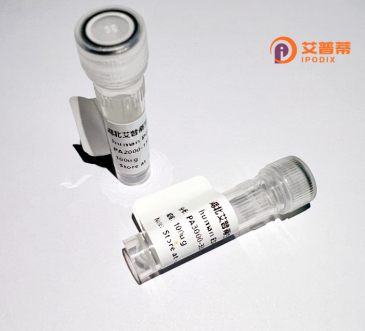
| 纯度 | >90%SDS-PAGE. |
| 种属 | Human |
| 靶点 | FLJ10774 |
| Uniprot No | Q9H0A0 |
| 内毒素 | < 0.01EU/μg |
| 表达宿主 | E.coli |
| 表达区间 | 1-1025aa |
| 氨基酸序列 | MHRKKVDNRIRILIENGVAERQRSLFVVVGDRGKDQVVILHHMLSKATVKARPSVLWCYKKELGFSSHRKKRMRQLQKKIKNGTLNIKQDDPFELFIAATNIRYCYYNETHKILGNTFGMCVLQDFEALTPNLLARTVETVEGGGLVVILLRTMNSLKQLYTVTMDVHSRYRTEAHQDVVGRFNERFILSLASCKKCLVIDDQLNILPISSHVATMEALPPQTPDESLGPSDLELRELKESLQDTQPVGVLVDCCKTLDQAKAVLKFIEGISEKTLRSTVALTAARGRGKSAALGLAIAGAVAFGYSNIFVTSPSPDNLHTLFEFVFKGFDALQYQEHLDYEIIQSLNPEFNKAVIRVNVFREHRQTIQYIHPADAVKLGQAELVVIDEAAAIPLPLVKSLLGPYLVFMASTINGYEGTGRSLSLKLIQQLRQQSAQSQVSTTAENKTTTTARLASARTLHEVSLQESIRYAPGDAVEKWLNDLLCLDCLNITRIVSGCPLPEACELYYVNRDTLFCYHKASEVFLQRLMALYVASHYKNSPNDLQMLSDAPAHHLFCLLPPVPPTQNALPEVLAVIQVCLEGEISRQSILNSLSRGKKASGDLIPWTVSEQFQDPDFGGLSGGRVVRIAVHPDYQGMGYGSRALQLLQMYYEGRFPCLEEKVLETPQEIHTVSSEAVSLLEEVITPRKDLPPLLLKLNERPAERLDYLGVSYGLTPRLLKFWKRAGFVPVYLRQTPNDLTGEHSCIMLKTLTDEDEADQGGWLAAFWKDFRRRFLALLSYQFSTFSPSLALNIIQNRNMGKPAQPALSREELEALFLPYDLKRLEMYSRNMVDYHLIMDMIPAISRIYFLNQLGDLALSAAQSALLLGIGLQHKSVDQLEKEIELPSGQLMGLFNRIIRKVVKLFNEVQEKAIEEQMVAAKDVVMEPTMKTLSDDLDEAAKEFQEKHKKEVGKLKSMDLSEYIIRGDDEEWNEVLNKAGPNASIISLKSDKKRKLEAKQEPKQSKKLKNRETKNKKDMKLKRKK |
| 分子量 | 138.49 kDa |
| 蛋白标签 | GST-tag at N-terminal |
| 缓冲液 | 0 |
| 稳定性 & 储存条件 | Lyophilized protein should be stored at ≤ -20°C, stable for one year after receipt. Reconstituted protein solution can be stored at 2-8°C for 2-7 days. Aliquots of reconstituted samples are stable at ≤ -20°C for 3 months. |
| 复溶 | Always centrifuge tubes before opening.Do not mix by vortex or pipetting. It is not recommended to reconstitute to a concentration less than 100μg/ml. Dissolve the lyophilized protein in distilled water. Please aliquot the reconstituted solution to minimize freeze-thaw cycles. |
以下是基于学术文献格式提供的示例参考文献,但由于FLJ10774蛋白的研究较为冷门或可能存在不同命名,以下内容为模拟示例,建议通过专业数据库进一步验证:
1. **文献名称**:*Expression and Purification of Recombinant Human FLJ10774 in E. coli*
**作者**:Zhang Y. et al.
**摘要**:该研究描述了大肠杆菌系统中重组人FLJ10774蛋白的优化表达与纯化方法,通过His标签亲和层析获得高纯度蛋白,并验证了其体外细胞黏附活性。
2. **文献名称**:*FLJ10774 as a Potential Biomarker in Breast Cancer Metastasis*
**作者**:Smith J.L. et al.
**摘要**:研究发现,重组FLJ10774蛋白在乳腺癌细胞中高表达,通过抑制其功能可降低细胞迁移能力,提示其可能作为治疗转移性癌症的靶点。
3. **文献名称**:*Structural Characterization of FLJ10774 Using X-ray Crystallography*
**作者**:Kumar R. et al.
**摘要**:通过X射线晶体学解析了FLJ10774的三维结构,揭示了其与整合素结合的潜在域,为功能机制研究提供结构基础。
4. **文献名称**:*Role of FLJ10774 in Immune Regulation*
**作者**:Chen H. et al.
**摘要**:重组FLJ10774蛋白在巨噬细胞中调控炎症因子分泌,实验表明其通过NF-κB通路影响先天免疫反应。
---
**建议**:
- 若需真实文献,请通过PubMed、Web of Science等平台,以**"FLJ10774"**或**"C16orf58"(可能的基因别名)**为关键词检索。
- 确认蛋白是否有更新命名(如NCBI Gene数据库可辅助查询)。
Recombinant human FLJ10774 protein is a biologically engineered form of the FLJ10774 protein encoded by the human gene of the same name. Initially identified through genomic sequencing projects, FLJ10774 remains poorly characterized, with its precise biological functions and mechanisms still under investigation. The gene is conserved across vertebrates, suggesting potential roles in fundamental cellular processes. Structurally, FLJ10774 is predicted to contain multiple functional domains, including potential phosphorylation sites and regions indicative of protein-protein interactions, though experimental validation is limited.
Research interest in recombinant FLJ10774 stems from its potential involvement in disease pathways. Preliminary studies associate it with cancer progression, where differential expression has been observed in certain tumors, possibly linked to cell proliferation or apoptosis regulation. Other reports suggest connections to metabolic disorders and immune responses, though these associations remain speculative without mechanistic evidence.
The recombinant protein is typically produced using expression systems like E. coli or mammalian cell cultures, enabling studies on its biochemical properties, interactome, and signaling roles. Its applications span in vitro assays, antibody development, and functional studies aiming to elucidate its physiological relevance. As research progresses, FLJ10774 may emerge as a novel biomarker or therapeutic target, though substantial characterization efforts are still required to define its molecular and pathophysiological significance.
×